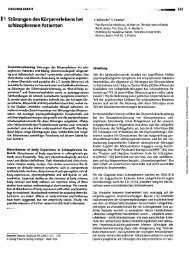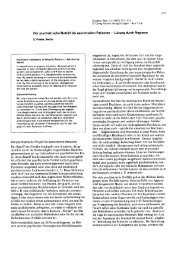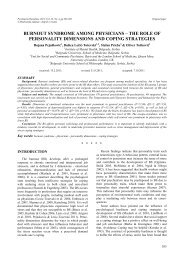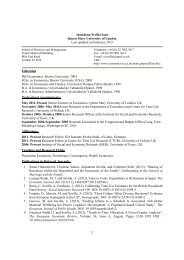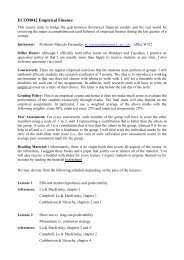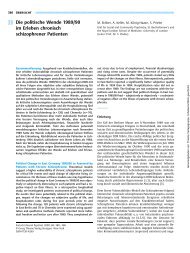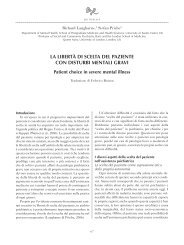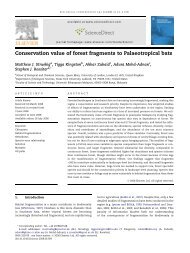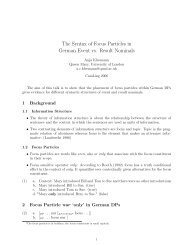Proofs - Personal Webspace for QMUL - Queen Mary, University of ...
Proofs - Personal Webspace for QMUL - Queen Mary, University of ...
Proofs - Personal Webspace for QMUL - Queen Mary, University of ...
Create successful ePaper yourself
Turn your PDF publications into a flip-book with our unique Google optimized e-Paper software.
That the model is false suggests that consciousness must be<br />
acquainted with itself immediately, independently <strong>of</strong> objectifi cation<br />
by a successive consciousness. Fichte expresses this by talking <strong>of</strong><br />
the complete non- differentiability <strong>of</strong> subject and object in self-<br />
consciousness (compare Sartre [51, p. 382]). In Kantian terminology,<br />
such an immediate consciousness is an intuition (Anschauung);<br />
in contrast to sensory intuition it has no object in space and time.<br />
4. Excursion: an Eastern answer to circularity<br />
and some similarities in neurophilosophical approaches<br />
Another answer to the question whether there is an internal<br />
spectator <strong>of</strong> perceptions and ideas who guarantees their unity is<br />
given by some <strong>for</strong>ms <strong>of</strong> Buddhism, particularly Zen- Buddhism.<br />
Based on Hinduism, in which the individual soul (Atman) is<br />
supposed to participate in the absolute (Brahman), Buddhism<br />
focuses on the danger that a human being may confuse her or<br />
his individual “concept” <strong>of</strong> the own soul with the absolute soul<br />
itself [43]. This danger may also be refl ected in Hume’s words:<br />
“When I turn my refl ection on myself, I never can perceive this<br />
self without some one or more perceptions” [27]. To mistake an<br />
idea <strong>of</strong> the own soul with the soul itself would thus be akin to<br />
mistaking the slide projected by a projection machine with the<br />
projection machine itself. Buddhism tries to avoid this danger by<br />
negating the idea <strong>of</strong> an individual self. According to Allen Watts,<br />
a proponent <strong>of</strong> Zen concepts, it is important to be aware that I am<br />
not this body, this perception, these feelings, these thoughts or<br />
this consciousness – that the basic reality <strong>of</strong> anyone’s life is not<br />
identical with any imaginable object. Instead, the self is basically<br />
defi ned by a categorical difference from any specifi c concept <strong>of</strong><br />
consciousness or perception – it has “never been seen”, “relates<br />
to nothing”, and it “neither can be touched nor described” [64].<br />
A helpful metaphor to understand this approach may be the<br />
statement that “light cannot shine upon itself”.<br />
Comparable concepts have been proposed by Metzinger<br />
(2005), a contemporary philosopher. Based on his interpretation<br />
<strong>of</strong> phantom limb perception, Metzinger suggested that our<br />
ideas <strong>of</strong> “ourselves”, the so called “phenomenal self – model”<br />
are a concept created by the brain, i.e. the result <strong>of</strong> processing<br />
in<strong>for</strong>mation and input in the central nervous system [42].<br />
Unlike all other perceptions and impressions, the self- model is<br />
characterized by continuous sensory and sensitive input from<br />
internal organs, body representations and other senses. Further,<br />
the brain- created self model, the “virtual self”, would be characterized<br />
by a reduced representation <strong>of</strong> processes occurring in the<br />
real world. Metzinger emphasizes that our virtual self moving<br />
in the perceived “phenomenal world” carries no brain, no motor<br />
system and no sensory organs: “Parts <strong>of</strong> the environment appear<br />
directly in its mind, the process <strong>of</strong> perception is ef<strong>for</strong>tless and<br />
immediate. Also, we experience body movements as directly<br />
initiated. However, we are not aware that our virtual self is a<br />
construction <strong>of</strong> the brain” [42]. Instead, Metzinger suggested<br />
that the brain or central nervous system fails to recognize its<br />
own self- model as a self- created model on the level <strong>of</strong> conscious<br />
experience. And he warns human beings not to confuse their own<br />
picture <strong>of</strong> themselves with these selves [42]. Buddhism may add<br />
that such confusion has adverse consequences beyond theoretical<br />
confusion, and that the identifi cation with our own wishes,<br />
A. Heinz et al. / European Psychiatry 27 (2012) / supplement n°2 / S32-S43 S35<br />
abilities and successes will necessarily lead into suffering. Watts<br />
(1981) there<strong>for</strong>e suggested that self- liberation is a continuous<br />
process <strong>of</strong> separating the self from any kind <strong>of</strong> identifi cation [64].<br />
5. Prerefl ective self- awareness versus<br />
a narrative self concept?<br />
So how is the phenomenal self- model constructed, at least in<br />
the Western tradition? Metzinger suggested that three phenomenal<br />
qualities characterize the self- model: 1) “Mineness (Meinigkeit)”,<br />
the sense that <strong>for</strong> example “my leg” has always belonged to me, 2)<br />
“Prerefl ective Self-awareness”, an intimate knowledge <strong>of</strong> the self<br />
that is prerefl ective and constitutes the experience <strong>of</strong> myself as an<br />
“ego” as a fundamental fact <strong>of</strong> experience, and 3) “Perspectivity”,<br />
a kind <strong>of</strong> central perspective which centres all consciously experienced<br />
objects around the acting and experiencing subject. All<br />
these characteristic qualities <strong>of</strong> self- experience can supposedly<br />
be altered in mental disorders, e.g. in acute schizophrenia, when<br />
consciously experienced thoughts are no longer perceived as my<br />
own [42]. Interestingly, this assumption is in contradiction with<br />
Kant’s hypothesis, that the “I think” can necessarily be placed in<br />
front <strong>of</strong> each <strong>of</strong> my thoughts without itself being accompanied by<br />
an act <strong>of</strong> sense perception – if Kant is right, then why can a patient<br />
suffering from acute psychosis experience a lack <strong>of</strong> ownership<br />
<strong>of</strong> his own thoughts, e.g. if the thought is experienced as being<br />
“projected into the mind” by some <strong>for</strong>eign <strong>for</strong>ce? Does this mean<br />
that there is a certain feeling or perception <strong>of</strong> ownership associated<br />
with one’s own thoughts that can be lost in psychosis? And if so,<br />
how can this ownership <strong>of</strong> thoughts be understood?<br />
It is <strong>of</strong>ten assumed that a person’s relationship to his or her<br />
own thoughts can be conceptualised in the same way as his or her<br />
relationship to intentional objects or objects <strong>of</strong> perception. For<br />
example, if I focus my attention not on the perception <strong>of</strong> a tree<br />
but on myself as I perceive this tree, the resulting shift <strong>of</strong> attention<br />
from the object <strong>of</strong> attention to “my self” as a perceiving subject is<br />
supposed to result in refl ective self- consciousness. However, how<br />
do I know that it is actually me who processes these thoughts or<br />
feelings? How is my intimate relationship with myself grounded<br />
in this experience? Different hypotheses tried to answer these<br />
questions. For example, Mead suggested that this relationship<br />
to myself is established by a certain condition <strong>of</strong> (pre)lingual<br />
communication: this hypothesis suggests that whenever I voice<br />
an opinion, I react to it in the same way as my partner in communication<br />
would do. There<strong>for</strong>e, I acquire an excentric perspective,<br />
which provides me with a picture or perception <strong>of</strong> myself and<br />
thus endows me with an awareness <strong>of</strong> my own identity [25].<br />
This hypothesis suggests that I perceive myself like a partner in<br />
communication would do, i.e. that the third person perspective<br />
is primary and that my fi rst person perspective is derived from<br />
it. However, this has been negated by other philosophers; <strong>for</strong><br />
example Frank [14] pointed to the work <strong>of</strong> Henrich and suggested<br />
that there has to be a primary intimate awareness <strong>of</strong> my own self,<br />
which is prerefl ective and in itself necessary in order to attribute<br />
any object <strong>of</strong> refl ection to myself. Otherwise, how should I know<br />
that a certain utterance or thought actually belongs “to me”?<br />
Thus, any attempt to perceive self- consciousness (“Ichheit”)<br />
as arising from refl ectivity cannot escape the circularity <strong>of</strong> the<br />
infi nite regress. This means that whenever such attempts tried<br />
<strong>Pro<strong>of</strong>s</strong>




